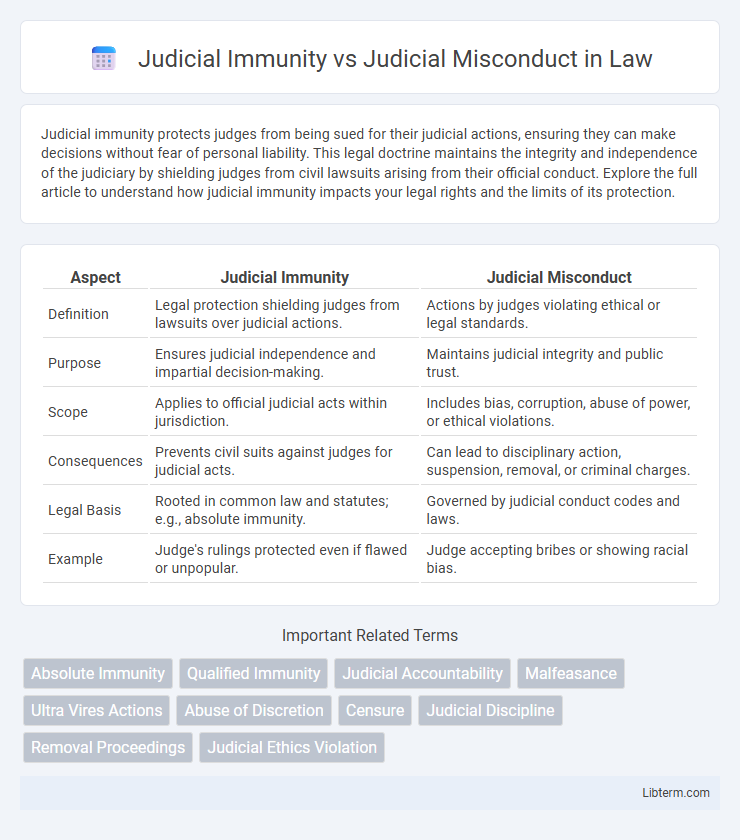Judicial immunity protects judges from being sued for their judicial actions, ensuring they can make decisions without fear of personal liability. This legal doctrine maintains the integrity and independence of the judiciary by shielding judges from civil lawsuits arising from their official conduct. Explore the full article to understand how judicial immunity impacts your legal rights and the limits of its protection.
Table of Comparison
| Aspect | Judicial Immunity | Judicial Misconduct |
|---|---|---|
| Definition | Legal protection shielding judges from lawsuits over judicial actions. | Actions by judges violating ethical or legal standards. |
| Purpose | Ensures judicial independence and impartial decision-making. | Maintains judicial integrity and public trust. |
| Scope | Applies to official judicial acts within jurisdiction. | Includes bias, corruption, abuse of power, or ethical violations. |
| Consequences | Prevents civil suits against judges for judicial acts. | Can lead to disciplinary action, suspension, removal, or criminal charges. |
| Legal Basis | Rooted in common law and statutes; e.g., absolute immunity. | Governed by judicial conduct codes and laws. |
| Example | Judge's rulings protected even if flawed or unpopular. | Judge accepting bribes or showing racial bias. |
Understanding Judicial Immunity: Definition and Purpose
Judicial immunity is a legal doctrine that protects judges from personal liability for actions performed within their judicial capacity, ensuring decisions are made without fear of personal consequences. Its primary purpose is to uphold judicial independence and maintain impartiality by shielding judges from lawsuits arising from their official duties. This immunity, however, does not extend to acts outside the judge's jurisdiction or cases of clear misconduct, where accountability mechanisms for judicial misconduct come into play.
Historical Origins of Judicial Immunity
Judicial immunity originated in English common law during the 18th century as a principle ensuring judges' decisions could not be challenged through personal lawsuits, thereby protecting judicial independence and preventing compromised rulings due to fear of personal liability. This doctrine was solidified in the landmark U.S. Supreme Court case, Bradley v. Fisher (1872), which established absolute immunity for judges performing judicial acts. While judicial immunity safeguards judges from civil suits, it does not shield against judicial misconduct, which involves unethical or illegal actions subject to disciplinary measures or removal.
Judicial Immunity in Practice: Scope and Limitations
Judicial immunity protects judges from liability for actions performed within their judicial capacity, ensuring impartial decision-making and independence from external pressures. This immunity covers official judicial acts but does not extend to actions taken outside the judge's jurisdiction or for non-judicial conduct, where immunity can be challenged. Exceptions to judicial immunity include acts done in the clear absence of jurisdiction or cases involving corrupt or malicious behavior, limiting the scope to uphold accountability without undermining judicial authority.
Defining Judicial Misconduct: Types and Examples
Judicial misconduct encompasses actions by judges that violate ethical standards or laws, including bias, corruption, and abuse of power. Common types involve conflict of interest, inappropriate behavior in court, and failure to uphold impartiality. Examples include accepting bribes, engaging in discriminatory rulings, or using judicial authority to intimidate parties.
Key Differences Between Judicial Immunity and Judicial Misconduct
Judicial immunity protects judges from liability for actions performed within their judicial capacity, ensuring judicial independence by shielding them from lawsuits. Judicial misconduct involves unethical or illegal behavior by judges, such as bias, corruption, or abuse of power, which undermines the integrity of the judiciary. The key difference lies in immunity providing legal protection for official acts, whereas misconduct constitutes violations subject to investigation and disciplinary action.
Mechanisms for Addressing Judicial Misconduct
Mechanisms for addressing judicial misconduct include formal complaint processes handled by judicial conduct commissions, which investigate allegations of ethical violations by judges. In severe cases, mechanisms such as impeachment or removal proceedings are utilized to ensure accountability while preserving judicial immunity from civil suits for actions within judicial capacity. Transparency and enforcement of judicial codes of conduct play a crucial role in maintaining public trust and addressing improper behavior effectively.
Case Studies: When Immunity Meets Misconduct
Judicial immunity protects judges from liability for acts performed within their judicial capacity, as established in landmark cases like Stump v. Sparkman (435 U.S. 349, 1978), where immunity was upheld despite controversial decisions. However, instances of judicial misconduct, such as in the case of Judge Mark Ciavarella, convicted in Operation Greylord for corruption and abuse of power, reveal the limits of immunity when criminal acts are involved. Case studies highlight the tension between preserving judicial independence and ensuring accountability, emphasizing the need for oversight mechanisms to address misconduct without undermining immunity's role in judicial decision-making.
The Role of Oversight Bodies in Judicial Accountability
Oversight bodies play a critical role in balancing judicial immunity with accountability by investigating allegations of judicial misconduct without undermining judicial independence. These entities, such as judicial review commissions or ethics committees, ensure that judges adhere to ethical standards while protecting them from frivolous lawsuits. Effective oversight contributes to public trust in the judiciary by maintaining integrity and addressing instances of bias, corruption, or abuse of power.
Balancing Judicial Independence with Accountability
Judicial immunity protects judges from civil liability to ensure decisions are made without fear of personal repercussions, preserving judicial independence critical for impartial justice. Judicial misconduct, including actions like bias or corruption, undermines public trust and demands mechanisms for accountability to maintain the judiciary's integrity. Balancing these interests requires clear legal standards and oversight bodies to hold judges accountable without compromising their ability to rule independently.
Future Challenges and Reforms in Judicial Immunity and Conduct
Future challenges in judicial immunity revolve around balancing the protection of judges from frivolous lawsuits with ensuring accountability for judicial misconduct. Reforms may include clearer standards for immunity limits, enhanced transparency in judicial disciplinary processes, and improved mechanisms for addressing abuses without undermining judicial independence. Technological advancements and evolving public expectations will drive the need for adaptive policies that safeguard impartiality while promoting ethical conduct.
Judicial Immunity Infographic

 libterm.com
libterm.com